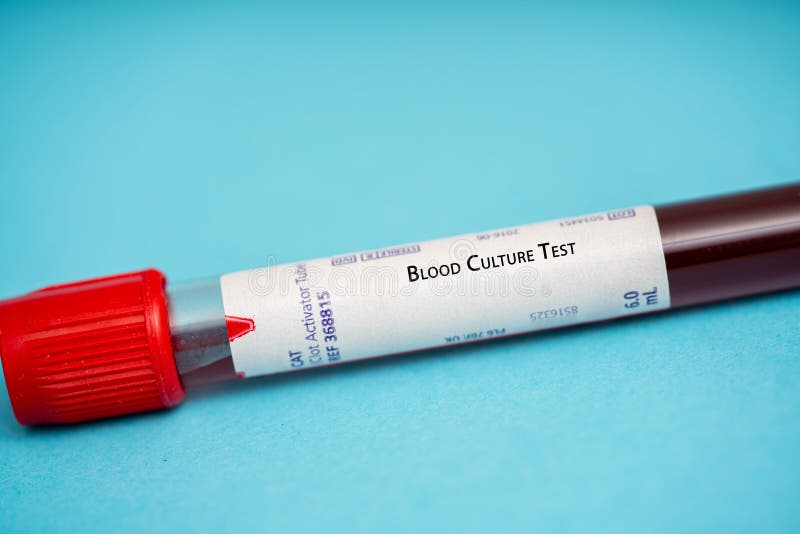Imagine waking up one morning feeling feverish, weak, and achy. You visit your doctor, who suspects a serious infection. To confirm their diagnosis, they order a blood culture – a test that can provide crucial insights into the presence of microorganisms lurking in your bloodstream.

Image: www.dreamstime.com
Blood cultures are a vital diagnostic tool in the fight against infections. They play a critical role in identifying the specific type of bacteria, fungus, or yeast causing an infection, allowing doctors to prescribe the most effective treatment. In this article, we’ll delve into the world of blood cultures, exploring their purpose, procedures, and importance in combating life-threatening infections.
Understanding the Importance of Blood Cultures
Blood cultures are laboratory tests that help identify the presence of microorganisms in a patient’s bloodstream. These microorganisms, such as bacteria, fungi, and yeast, can cause a life-threatening condition known as bacteremia, fungemia, or septicemia. These infections can spread quickly throughout the body, affecting various organs and systems.
Prompt identification of the infectious agent through blood cultures is crucial for timely intervention with appropriate antibiotics or antifungal medications. This can significantly improve the chances of a successful recovery and prevent serious complications.
The Procedure of Blood Culture Collection
Blood culture collection involves collecting a small sample of blood from a patient’s vein. The sample is then transferred to specialized bottles containing a nutrient-rich broth. These bottles provide an environment conducive to the growth of microorganisms. The bottles are incubated at a specific temperature, allowing any microbes present in the blood to multiply.
Once the microorganisms have grown sufficiently, they are identified through a process called “culturing.” This involves isolating the microorganisms on a solid medium, such as an agar plate. Different growth patterns and characteristics of the microorganisms help determine their identity.
The blood culture method is delicate and requires strict sterile technique to prevent the introduction of contaminants. This ensures accurate results and avoids misdiagnosis.
Analyzing Blood Culture Results
Blood culture results can take up to a few days to become available, as it takes time for the microorganisms to grow in the broth. When results are positive, they provide crucial information about the type of microorganism causing the infection and its susceptibility to specific antibiotics. This information aids in tailoring the most effective treatment plan.
Negative results, however, do not necessarily rule out an infection. There are various reasons for negative results, including incorrect collection technique, low bacterial count in the blood, or a recent antibiotic course. Further tests or investigations may be needed to confirm or rule out an infection in such cases.

Image: www.researchgate.net
Trends and Developments in Blood Culture Testing
The field of blood culture testing is constantly evolving, with advancements aimed at improving accuracy, reducing turnaround time, and simplifying blood culture collection procedures. One notable development is the use of automated blood culture systems. These systems monitor the bottles continuously, detecting microbial growth at an earlier stage, leading to quicker identification and initiation of treatment.
Another significant advancement is the rapid identification methods, such as polymerase chain reaction (PCR) testing. PCR allows for detection of specific DNA sequences within the microorganisms, enabling faster identification compared to traditional culturing methods. This can be particularly beneficial in cases where time is of the essence, for example, in managing critically ill patients.
Tips and Expert Advice for Patients and Practitioners
For patients undergoing blood culture testing, it’s essential to understand the procedure and potential implications. Sharing your medical history and any recent medications or supplements with your doctor is crucial for accurate diagnosis and treatment. It’s also crucial to follow the doctor’s instructions regarding the collection process and any post-procedure care.
For healthcare practitioners, staying abreast of the latest advancements in blood culture testing is essential. This includes using evidence-based guidelines for blood culture collection, interpreting results accurately, and understanding the limitations of different methods. It is vital to communicate with patients about the purpose, procedure, and potential outcomes of blood culture testing.
FAQs about Blood Culture Testing
Q1: What does a positive blood culture result mean?
A positive blood culture result indicates the presence of microorganisms in the bloodstream, signifying an infection.
Q2: What are the risks associated with blood culture testing?
Blood culture testing is generally safe, the risks are minimal. However, as with any blood draw, there is a slight risk of bruising, bleeding, or infection at the puncture site.
Q3: How often do blood cultures need to be repeated?
The frequency of blood culture repetition depends on the clinical situation. For example, in cases of suspected sepsis, multiple blood cultures may be collected over a short period to identify the source of infection and monitor treatment effectiveness.
Q4: Can I have a blood culture done at home?
Blood cultures are typically performed in a clinical setting, as they require sterile collection techniques and laboratory analysis. However, there are home-based blood collection kits for various other tests.
Q5: Who should get a blood culture test?
Blood cultures are typically ordered for individuals with symptoms suggestive of infection, such as fever, chills, rapid heart rate, and low blood pressure. They are also recommended for patients with weakened immune systems, those undergoing certain medical procedures, and those with a history of recurrent infections.
Blood Cultures Are Tests For
Conclusion
Blood cultures are vital diagnostic tools that play a crucial role in identifying and understanding bloodstream infections. Advancements in technology are continually improving the accuracy and speed of these tests, aiding in timely diagnosis and treatment. By understanding the purpose and procedure of blood culture testing, both patients and healthcare providers can contribute to effective infection management and patient care.
Are you interested in learning more about blood culture testing or have any further questions? Leave a comment below, and we’ll be happy to provide more information.





